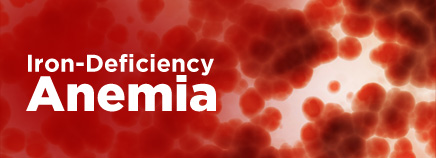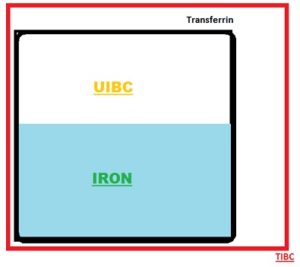Iron Blood Test and Normal Iron Levels Chart by Age
A quick summary of iron blood test:
- Serum iron blood test measures how much iron inside the body.
- Ferritin test measures how much iron is stored inside cells.
- TIBC test (total iron-binding capacity) measures all proteins needed to link iron including transferrin (means the total transferring available).
- UIBC test (unsaturated iron-binding capacity) measures how much iron for saturation of transferrin.
- Transferrin saturation is a calculated percentage to tell how much transferrin is full with iron.
- Morning iron is higher than the rest of the day’s iron levels by 30%.
- 67% of the body’s iron is inside hemoglobin in red blood cells, other iron is bound to transferrin in blood or ferritin in bone marrow, or stored in more body tissues.
- 3.5% of the total iron in the body is inside Muscles as myoglobin.
- 27% of all iron inside cells are stored in Ferritin & hemosiderin.
- Children and women need more of iron than adult men that’s because children need iron for growth, also woman has menses bleeding every month.

Did You know: What does anemic mean?
Sorry Iron tests is a long story, please bookmark this page and read carefully to understand your case better.
What causes iron deficiency?
You have iron deficiency anemia when your lab results are lower than normal levels as seen in iron blood test results.
Causes of shortage of iron in the body include:
- Body lose iron through excessive urination, exfoliating of old skin cells, defecation, and sweating.
- Poor diets that has insufficient iron and essential elements.
- Imbalanced diet and vegetarian diets only contain non-heme iron, which is difficult for absorption.
- Iron uptake problem when you have stomach or intestine diseases.
- Losing Iron through intended blood loss through heavy bleeding, injuries, during surgery, or repeated blood drawings.
- High demand for iron during pregnancy, breastfeeding, adolescence, and bodybuilding programs.
- Excess loss of iron through monthly bleeding in women, gastrointestinal bleeding through ulcers and cancers.
How doctors write iron tests?
Doctors usually write: Fe Tests, Iron Indices, iron test, iron panel, Fe+2; Ferric ion; Fe++, Ferrous ion, ferrous test, Iron – serum; Anemia – serum iron; Hemochromatosis – serum iron
Iron tests panel include: Serum Iron, Ferritin; TIBC, UIBC and Transferrin; Zinc Protoporphyrin; Complete Blood Count; Hemoglobin; Hematocrit; Reticulocyte Count; Soluble Transferrin Receptor

When to do iron tests?
If you’re complaining of one or more of the following, then you should test for iron deficiency:
- Fatigue and unexplained weakness are common signs you should test iron.
- Pale skin, a tingling or crawling feeling in the legs, shortness of breath, and dizziness are signs of severe anemia and marked iron shortage.
- When a child has strange cravings to eat non-food items, I mean dirt, ice, or clay then it’s the time to know how much iron your kid has.
What is serum iron in blood test?
Serum iron is a medical laboratory test means how much total iron is in your blood, for best evaluation of body’s content of iron the doctor must request all anemia test including; serum iron, TIBC, Ferritin, transferrin, and transferrin saturation tests.
Do you have to fast for an iron blood test?
Here’s what to do before taking a blood test for iron:
- 8 hours fasting before a blood test for iron, TIBC, or transferrin.
- Ferritin test don’t need fasting before taking it.
- Pause iron pills 24 hours before testing time.
Read: all fasting blood test lists.
When to take iron blood test during the day?
- The best time to do iron tests is in the morning, when iron levels are at highest levels.
- Serum Iron level has diurnal variation. Morning iron levels are 30% higher than the whole day iron levels, because of Iron fluctuations during the day, serum iron test need more medical tests in order to indicate anemia.
- Full list: when to take a blood test?
What is the difference between iron and hemoglobin?
In a brief, hemoglobin consists of four iron atoms. Anemia diagnosis made upon measuring the levels of hemoglobin and iron together along with other diagnostic tests.
- Hemoglobin is the protein in red blood cells that carries inhaled oxygen from the lungs to the all organs, and returns carbon dioxide from the tissues back to the lungs to exhale.
- Consists of four protein molecules connected with four atoms of iron that can bind four atoms of oxygen.
- Iron is a trace element inside the red blood cells and other organs.
- Building hemoglobin during red cells production process that called hematopoiesis needs Iron.
- Iron mediates many other biochemical reactions in the body.
Have a look at: Normal hemoglobin levels
Normal Iron Levels Chart by Age
Explain: What is a normal iron level in blood test? what should your iron level be
Normal Ranges for Iron Tests Commonly Used to Assess Anemia (same for male and female, except noted)
| Test | Normal Ranges | Ranges in SI units |
| Serum Iron for Adult men | 70-175 mcg/dL | 12.5-31.3 mcmol/L |
| Serum Iron for Adult women | 50-150 mcg/dL | 8.9-26.8 mcmol/L |
| Serum Iron for children 6 mo-2 yr | 50-120 mcg/dL | 9.0-21.5 mcmol/L |
| Total iron-binding capacity | 250-460 µg/dL | 45 – 82 µmol/L |
| Percent Transferrin saturation for male | Male: 30 – 50% | |
| Percent Transferrin saturation for female | Female: 20 – 35% | |
| Serum Transferrin | 200 – 430 mg/dL | 2 – 3.8 g/L |
| Serum ferritin, male | 15-400 ng/mL | |
| Serum ferritin, female | 10-106 ng/mL | |
| Serum ferritin, child elder than 1 | 7 – 140 ng/mL | |
| Free serum hemoglobin | 0-10 mg/dL |
What causes high iron in the blood test?
Hemochromatosis means too much iron in the body and results are higher than normal ranges.
If the test is correct, the too much iron in the body can make iron toxicity, common causes
- Too much blood transfusions will cause iron level decline.
- Hemolytic anemia: too much red blood cells destruction.
- Cirrhosis or necrosis: Liver tissue death.
- Hepatitis: Inflammation of the liver.
- Iron poisoning and more serious complications in people taking iron to lower stress.
Difference between Hemosiderosis and hemochromatosis
Both are iron overload disorders:
- Hemosidrosis is abnormal deposition of hemosiderin in tissues. Hemosiderin is an iron-containing compound. It’s often associated with frequent blood transfusions in addition to extensive destruction of red blood cells such as sickle cell anemia and thalassemia.
- Hemochromatosis is an inherited or acquired iron metabolism disorder. Means that the body accumulates more iron than its need and can’t excrete the excess iron, leading to iron overload and dysfunction or failure of several organs; including heart, liver, pancreas. Hemochromatosis increases skin pigmentation that called “bronzing.”
What is the role of Iron in the Body?
Human being depends on a sufficient amount of iron that is must be circulating in our blood stream, iron is needed for:
- Moving oxygen around your body, and transport carbon dioxide back to exhalation from lungs.
- Haematopoiesis, which is the building process of RBC specifically used inside hemoglobin.
- In the conversion of blood sugar to energy, which benefits athlete muscles during exercises.
- The production of enzymes inside cells.
- Iron contributes to normal cognitive function in children and immune system depends on iron.
What do iron blood test results mean?
The common question between clinicians, medical students, and most people is; what does iron blood test results mean?
What’s the relationship between Iron, ferritin, TIBC, transferrin, and TRSF saturation?

Here’s a clarification based on medical consultations.
Iron and ferritin results meaning:
- If Iron levels increase, ferritin level increase and transferrin level decrease.
- If Iron levels decrease, ferritin level decrease and transferrin level increase.
The total iron-binding capacity
It is the amount of iron that is in demand to fully saturate transferrin.
- Normal TIBC value means 100% transferrin saturation with available iron.
- Total iron-binding capacity short form is TIBC.
- TIBC result is a useful marker in diagnosis of iron deficiency anemia and iron deficiency due to chronic disease,
- Elevated TIBC is an indicative of iron deficiency anemia (IDA).
- Low TIBC is a marker of anemia that is due to chronic disease.
UIBC is the unsaturated iron binding capacity: represents the additional amount of iron that can be bound or the empty sites from iron on transferrin protein.
UIBC calculation from the equation: UIBC = TIBC – iron
Transferrin Saturation Percentage is a medical laboratory value represents the saturation ratio of transferrin with iron atoms in the serum.
- Transferrin Saturation equation: Transferrin Saturation % = ( Serum iron x 100 )/ TIBC
The actual amount of iron found on transferrin (serum iron) divided by the total amount of iron fully saturated the transferrin (TIBC) - The normal range of transferrin saturation % is 20 – 50%.
What does Transferrin saturation% resultss mean?
- Transferrin saturation% means how much serum iron has links with transferrin.
- According to normal range, it is normal that the ratio of iron bound to transferrin protein in normal conditions is 20 – 50%, means that 50-70% of transferrin sites normally do not contain iron (empty, unsaturated sites)
- If Transferrin saturation is less than 20%, then the iron deficiency is more likely.
- If Transferrin saturation is more than 50%, then the iron overload is more likely.
Example of clarification:
If we assume that transferrin has 200 sites to bind the amount of iron.
If the transferrin has 50 iron atoms bound, and 150 of the sites are empty or not attached to any iron atom, this means that:
- 50% is the ratio of iron bound to transferrin in the blood = serum Iron value.
- 25% is the ratio of saturated iron = Transferrin Saturation %.
- 150 is the empty sites of iron on transferrin = UIBC
- 200 is the iron required to 100% saturation of transferrin = TIBC
Mentzer index
- Medical Lab equation.
- Used for differentiation between iron deficiency anemia and Mediterranean anemia.
- Mentzer index formula = MCV/ RBCs count
What do Mentzer results mean?
- Mentzer index that is greater than 13, thus iron deficiency anaemia is more likely.
- If Mentzer index is lower than 13, thus beta thalassemia is more likely.
Blood tests for anemia include:
- Complete blood count: includes hemoglobin, hematocrit that means the mass of red blood cells, and red cells count.
- CBC test includes 4 RBC’s estimated parameters: MCV that represents the size of cells, MCH that means the mass of hemoglobin in all RBCs, MCHC that reflects the density of hemoglobin in each RBC, and RDW estimates the distribution of RBC’s sizes.
- CBC test is test of choice to monitor anemia level.
- low hemoglobin levels and low hematocrit means Anemia.
- Doctors usually request iron blood test after discovering there is anemia in CBC results.
Haven’t know What is RBC?
Reticulocyte count (Retics):
- Measures absolute count or percentage of reticulocytes in a stained smear of a blood sample.
- The final stage of immature red blood cells is the Reticulocytes.
- Reticulocytes count means how much bone marrow is compensating red cells loss.
What does reticulocyte count results mean?
- Low Reticulocyte count in iron deficiency anemia and increase to the normal range after a course of treatment.
- High Reticulocyte count in hemolytic anemia.
What is your Iron blood test results?